High-Temperature Deformation Behavior and Microstructural Characterization of Ti-35421 Titanium Alloy
Abstract
:1. Introduction
2. Experimental Details
2.1. Experimental Sample
2.2. Experimental Procedure
2.3. Metallography and Analysis
3. Results and Discussions
3.1. Initial Microstructure
3.2. Flow Behavior
3.3. Apparent Constitutive Analysis
3.4. Microstructural Evolution
3.4.1. α + β Phase Region
3.4.2. β Phase Region
3.5. Working Hardening and Dynamic Softening
4. Conclusions
- The stress–strain curves of Ti-35421 alloy have obvious yielding behavior at a high strain rate. Mainly because of the sudden activation of the movable dislocation at the grain boundary.
- The deformation activation energies of Ti-35421 alloys are 349.44 kJ/mol and 140.19 kJ/mol in the α + β and β phase region, respectively, based on the establishment of constitutive equations. In addition, as the temperature increases, more activation energy is required for hot deformation.
- For the α + β phase region, dynamically α spheroidization and DRV is the dominant deformation mechanism at 0.01 s−1 strain rate, while the simple at 10 s−1 strain rate is controlled by local deformation and dynamical α precipitation. Lowering the deformation temperature leads to more precipitation of the α phase and coarsening.
- Based on the observation of the microstructure and stress–strain curves of the β phase region, the volume fraction of the new recrystallized grains is less than 10%, which means that DRV runs through the hot deformation process. DRX is more prone to occur at low strain rates rather than high strain rates.
- The samples at high strain rate undergo discontinuous softening, and the higher the temperature, the more obvious is the discontinuous softening effect.
Author Contributions
Funding
Conflicts of Interest
References
- Markovsky, P.E.; Bondarchuk, V.I.; Herasymchuk, O.M. Influence of grain size, aging conditions and tension rate on the mechanical behavior of titanium low-cost metastable beta-alloy in thermally hardened condition. Mater. Sci. Eng. A 2015, 645, 150–162. [Google Scholar] [CrossRef]
- Faller, K.; Froes, F.H. The use of titanium in family automobiles: Current trends. JOM 2001, 53, 27–28. [Google Scholar] [CrossRef]
- Esteban, P.G.; Bolzoni, L.; Ruiznavas, E.M.; Gordo, E. PM processing and characterisation of Ti–7Fe low cost titanium alloys. Powder Metall. 2011, 54, 242–252. [Google Scholar] [CrossRef] [Green Version]
- Wang, B.; Yao, X.; Liu, L.; Zhang, X.; Ding, X. Mechanical properties and microstructure in a fine grained Ti-5Al-5Mo-5V-1Cr-1Fe titanium alloy deformed at a high strain rate. Mater. Sci. Eng. A 2018, 736, 202–208. [Google Scholar] [CrossRef]
- Hua, K.; Xue, X.; Kou, H.; Fan, J.; Tang, B.; Li, J. Characterization of hot deformation microstructure of a near beta titanium alloy Ti-5553. J. Alloys Compd. 2014, 615, 531–537. [Google Scholar] [CrossRef]
- Fan, X.G.; Zhang, Y.; Gao, P.F.; Lei, Z.N.; Zhan, M. Deformation behavior and microstructure evolution during hot working of a coarse-grained Ti-5Al-5Mo-5V-3Cr-1Zr titanium alloy in beta phase field. Mater. Sci. Eng. A 2017, 694, 24–32. [Google Scholar] [CrossRef]
- Chang, H.; Zeng, W.D.; Luo, Y.Y.; Zhou, Y.G.; Zhou, L. Phase transformation and microstructure evolution in near beta Ti-B19 titanium alloy during aging treatment. Rare Metal Mater. Eng. 2006, 35, 1589–1592. [Google Scholar]
- Abd-elrhman, Y.; Gepreel, M.A.H.; Abdel-Moniem, A.; Kobayashi, S. Compatibility assessment of new V-free low-cost Ti–4.7Mo–4.5Fe alloy for some biomedical applications. Mater. Design 2016, 97, 445–453. [Google Scholar] [CrossRef]
- Zhu, X.X.; Chang, H.; Xie, Y.J.; Ding, L.; Li, H.; Cui, Y.W.; Li, J.J.; Tang, J.; Zhou, L. Hot Deformation Behavior of Two Kinds of TC4-xFe Alloys Based on Processing Map. Rare Met. Mater. Eng. 2017, 46, 204–210. [Google Scholar]
- Ahmed, M.; Savvakin, D.G.; Ivasishin, O.M.; Pereloma, E.V. The effect of cooling rates on the microstructure and mechanical properties of thermo-mechanically processed Ti–Al–Mo–V–Cr–Fe alloys. Mater. Sci. Eng. A 2013, 576, 167–177. [Google Scholar] [CrossRef] [Green Version]
- Borowy, K.H.; Krammer, K.H. On the properties of a new Titanium alloy (Ti–5Al–2.5Fe) as implant material. Titanium 84, Science and Technology, vol 2. Desche Ges Metallkunde EV. Munich 1985, 381–386. [Google Scholar]
- Bobbili, R.; Madhu, V. Constitutive modeling of dynamic flow behavior of Ti-5553 alloy. J. Alloys Compd. 2019, 787, 260–266. [Google Scholar] [CrossRef]
- Li, C.; Zhang, X.-Y.; Li, Z.-Y.; Zhou, K.-C. Hot Deformation of Ti-5Al-5Mo-5V-1Cr-1Fe Near β Titanium Alloys Containing Thin and Thick Lamellar α Phase. Mater. Sci. Eng. A 2013, 573, 75–83. [Google Scholar] [CrossRef]
- Korneva, A.; Straumal, B.; Kilmametov, A.; Gondek, u.; Ziba, P. Thermal stability and microhardness of metastable ω-phase in the Ti-3.3 at.% Co alloy subjected to high pressure torsion. J. Alloys Compd. 2020, 834, 155132. [Google Scholar] [CrossRef]
- Gao, P.F.; Guo, J.; Zhan, M.; Lei, Z.N.; Fu, M.W. Microstructure and damage based constitutive modelling of hot deformation of titanium alloys. J. Alloys Compd. 2020, 831, 154851. [Google Scholar] [CrossRef]
- Fan, J.K.; Kou, H.C.; Lai, M.J.; Tang, B.; Chang, H.; Li, J.S. Characterization of hot deformation behavior of a new near beta titanium alloy: Ti-7333. Mater. Des. 2013, 49, 945–952. [Google Scholar] [CrossRef]
- Lv, Y.-P.; Li, S.-J.; Zhang, X.-Y.; Chen, C.; Zhou, K.-C. Effects of strain rate on grain boundary evolution in Ti-55531 alloy. Mater. Sci. Technol. 2018, 34, 1880–1886. [Google Scholar] [CrossRef]
- Zhao, Q.; Yang, F.; Torrens, R.; Bolzoni, L. Comparison of hot deformation behaviour and microstructural evolution for Ti-5Al-5V-5Mo-3Cr alloys prepared by powder metallurgy and ingot metallurgy approaches. Mater. Design 2019, 169, 107682. [Google Scholar] [CrossRef]
- Lin, Y.C.; Pang, G.-D.; Jiang, Y.-Q.; Liu, X.-G.; Zhang, X.-Y.; Chen, C.; Zhou, K.-C. Hot compressive deformation behavior and microstructure evolution of a Ti-55511 alloy with basket-weave microstructures. Vacuum 2019, 169, 108878. [Google Scholar] [CrossRef]
- Chen, F.; Xu, G.; Cui, Y.; Chang, H. Optimization of Low-Cost Ti-35421 Titanium Alloy: Phase Transformation, Bimodal Microstructure, and Combinatorial Mechanical Properties. Materials 2019, 12, 2791. [Google Scholar] [CrossRef] [Green Version]
- Li, D.; Hui, S.X.; Ye, W.J.; Li, C.L. Microstructure and mechanical properties of a new high-strength and high-toughness titanium alloy. Rare Met. 2016, 1–7. [Google Scholar] [CrossRef]
- Sellars, C.M.; Mctegart, W.J. On the mechanism of hot deformation. Acta Metall. 1966, 14, 1136–1138. [Google Scholar] [CrossRef]
- Chen, M.-S.; Yuan, W.-Q.; Li, H.-B.; Zou, Z.-H. New insights on the relationship between flow stress softening and dynamic recrystallization behavior of magnesium alloy AZ31B. Mater. Charact. 2019, 147, 173–183. [Google Scholar] [CrossRef]
- Rezaei Ashtiani, H.R.; Parsa, M.H.; Bisadi, H. Effects of initial grain size on hot deformation behavior of commercial pure aluminum. Mater. Design 2012, 42, 478–485. [Google Scholar] [CrossRef]
- Kaibyshev, R.; Goloborodko, A.; Musin, F.; Nikulin, I.; Sakai, T. The Role of Grain Boundary Sliding in Microstructural Evolution during Superplastic Deformation of a 7055 Aluminum Alloy. Mater. Trans. 2002, 43, 2408–2414. [Google Scholar] [CrossRef] [Green Version]
- Mitchell, T.E.; Hirth, J.P.; Misra, A. Apparent activation energy and stress exponent in materials with a high Peierls stress. Acta Mater. 2002, 50, 1087–1093. [Google Scholar] [CrossRef]
- Wen, D.-X.; Lin, Y.C.; Li, X.-H.; Singh, S.K. Hot deformation characteristics and dislocation substructure evolution of a nickel-base alloy considering effects of δ phase. J. Alloys Compd. 2018, 764, 1008–1020. [Google Scholar] [CrossRef]
- Gao, Y.; Ma, G.; Zhang, X.; Xu, J. Microstructure evolution and hot deformation behavior of Ti-6.5Al–2Zr–1Mo–1V alloy with starting lamellar structure. J. Alloys Compd. 2019, 809, 151852. [Google Scholar] [CrossRef]
- Lin, Y.C.; Huang, J.; He, D.-G.; Zhang, X.-Y.; Wu, Q.; Wuang, L.-H.; Chen, C.; Zhou, K.-C. Phase transformation and dynamic recrystallization behaviors in a Ti55511 titanium alloy during hot compression. J. Alloys Compd. 2019, 795, 471–482. [Google Scholar] [CrossRef]
- Du, Z.; Xiao, S.; Liu, J.; Lv, S.; Xu, L.; Kong, F.; Chen, Y. Hot Deformation Behavior of Ti-3.5Al-5Mo-6V-3Cr-2Sn-0.5Fe Alloy in α + β Field. Metals 2015, 5, 216–227. [Google Scholar]
- Jia, D.; Sun, W.; Xu, D.; Yu, L.; Xin, X.; Zhang, W.; Qi, F. Abnormal dynamic recrystallization behavior of a nickel based superalloy during hot deformation. J. Alloys Compd. 2019, 787, 196–205. [Google Scholar] [CrossRef]
- Weiss, I.; Froes, F.H.; Eylon, D.; Welsch, G.E. Modification of alpha morphology in Ti-6Al-4V by thermomechanical processing. Metall. Trans. A 1986, 17, 1935–1947. [Google Scholar] [CrossRef]
- Zhu, Y.; Zeng, W.; Feng, F.; Sun, Y.; Han, Y.; Zhou, Y. Characterization of hot deformation behavior of as-cast TC21 titanium alloy using processing map. Mater. Sci. Eng. A 2011, 528, 1757–1763. [Google Scholar] [CrossRef]
- Guo, J.; Zhan, M.; Wang, Y.Y.; Gao, P.F. Unified modeling of work hardening and flow softening in two-phase titanium alloys considering microstructure evolution in thermomechanical processes. J. Alloys Compd. 2018, 767, 34–45. [Google Scholar] [CrossRef]
- Chen, J.; Li, J.; Tang, B.; Chen, Y.; Kou, H. Microstructure and texture evolution of a near β titanium alloy Ti-7333 during continuous cooling hot deformation. Prog. Nat. Sci. Mater. Int. 2019, 29, 50–56. [Google Scholar] [CrossRef]
- Ebied, S.; Hamada, A.; Borek, W.; Gepreel, M.; Chiba, A. High-temperature deformation behavior and microstructural characterization of high-Mn bearing titanium-based alloy. Mater. Charact. 2018, 139, 176–185. [Google Scholar] [CrossRef]
- Ji, G.; Li, Q.; Li, L. The kinetics of dynamic recrystallization of Cu–0.4Mg alloy. Mater. Sci. Eng. A 2013, 586, 197–203. [Google Scholar] [CrossRef]
- Li, Y.J.; Li, X.P.; Zhang, L.C.; Sercombe, T.B. Processing and properties of topologically optimised biomedical Ti-24Nb-4Zr-8Sn scaffolds manufactured by selective laser melting. Mater. Sci. Eng. 2015, 642, 268–278. [Google Scholar] [CrossRef]
- Liu, X.; Chu, P.K.; Ding, C. Surface modification of titanium, titanium alloys, and related materials for biomedical applications. Mater. Sci. Eng. R Rep. 2004, 47, 49–121. [Google Scholar] [CrossRef] [Green Version]
- McQueen, H.J. Development of dynamic recrystallization theory. Mater. Sci. Eng. A 2004, 387–389, 203–208. [Google Scholar] [CrossRef]
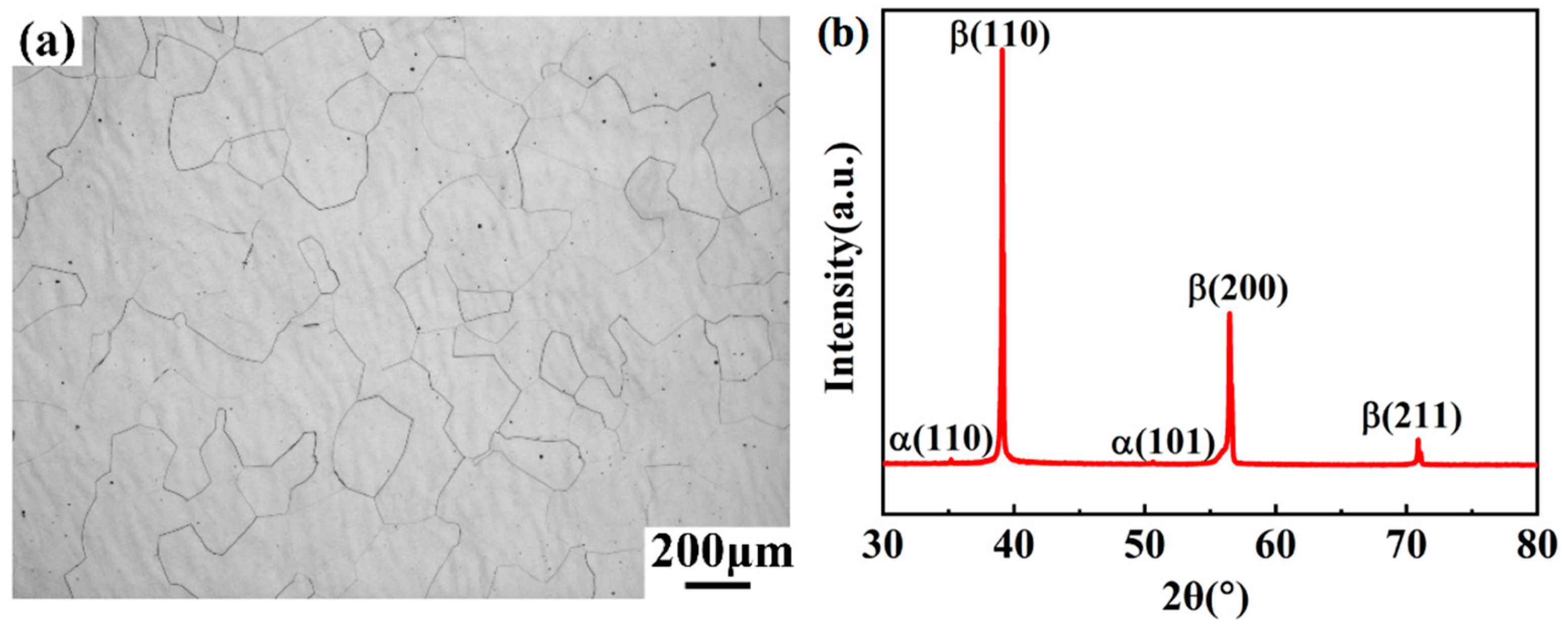

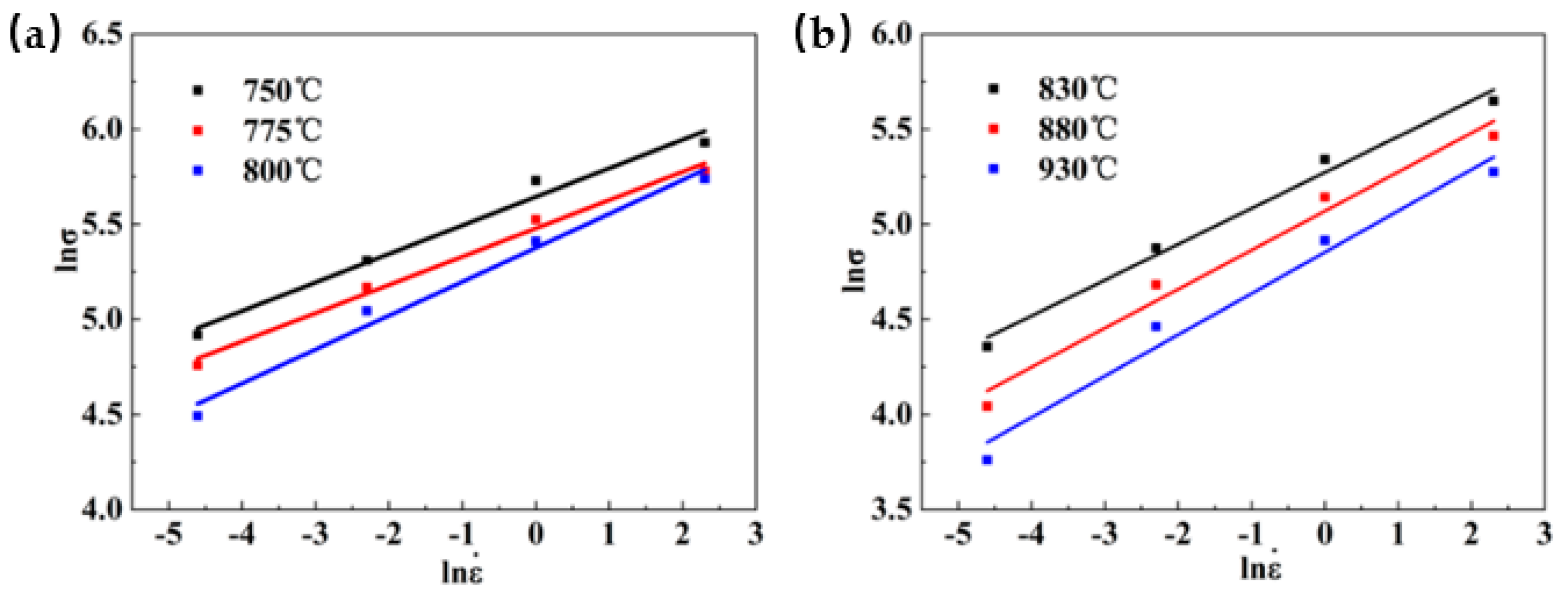
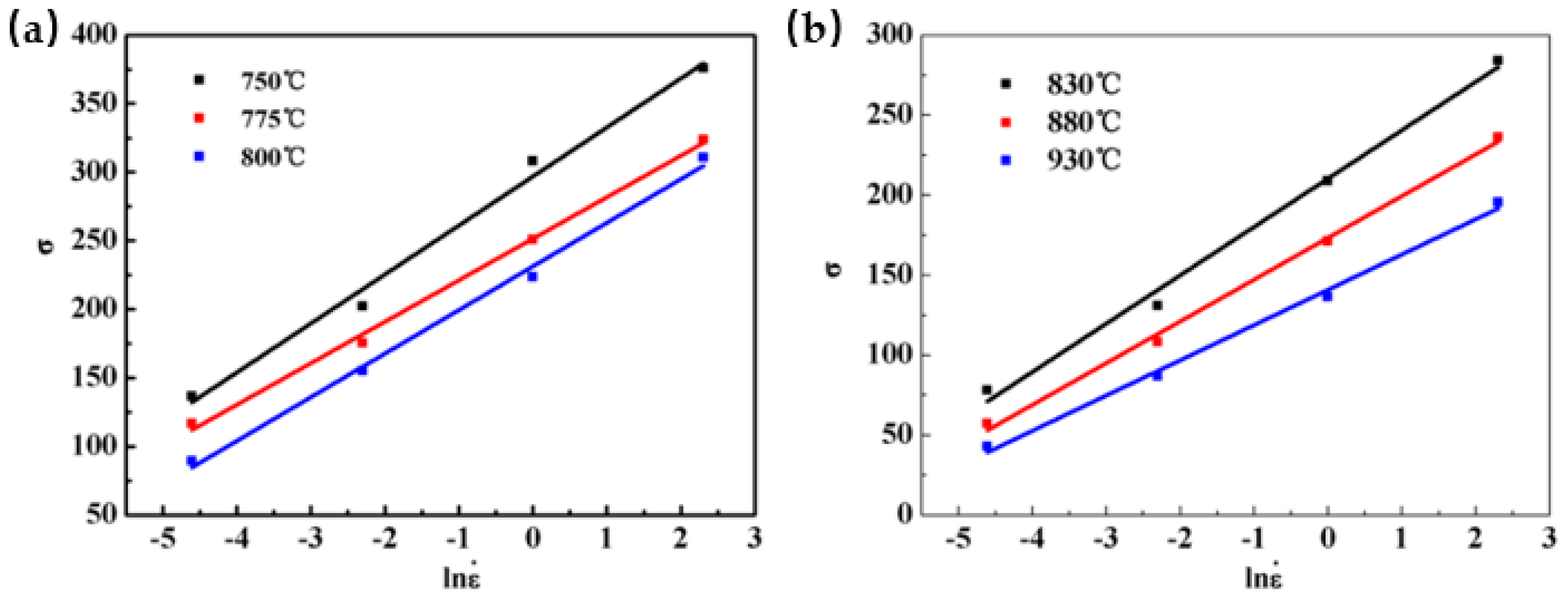

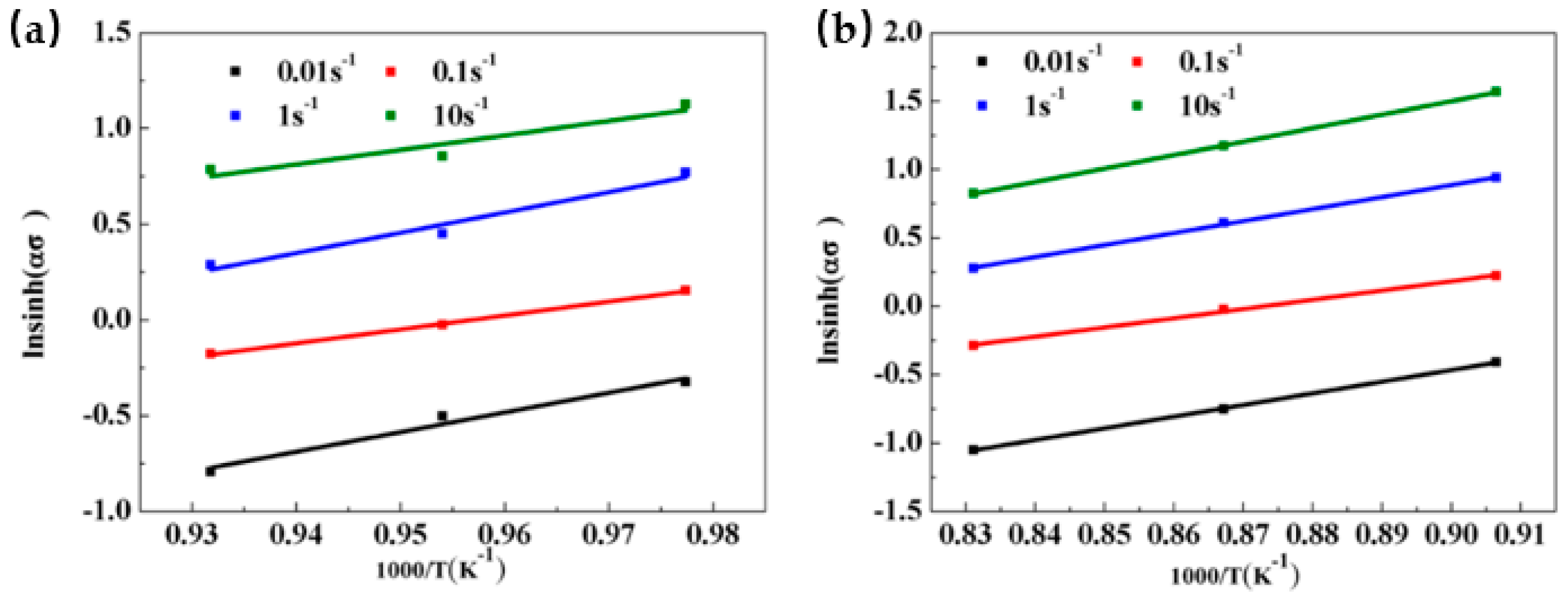

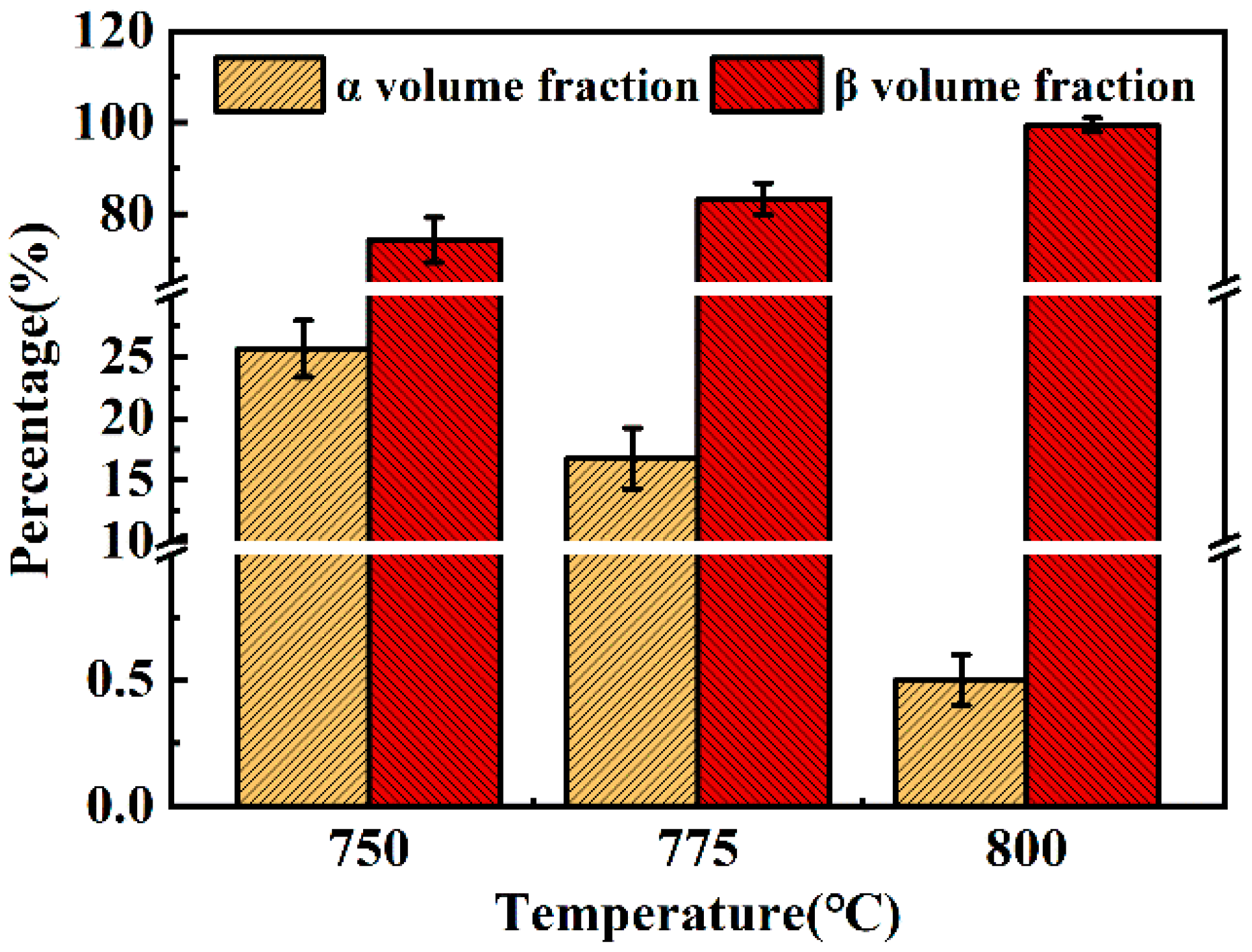
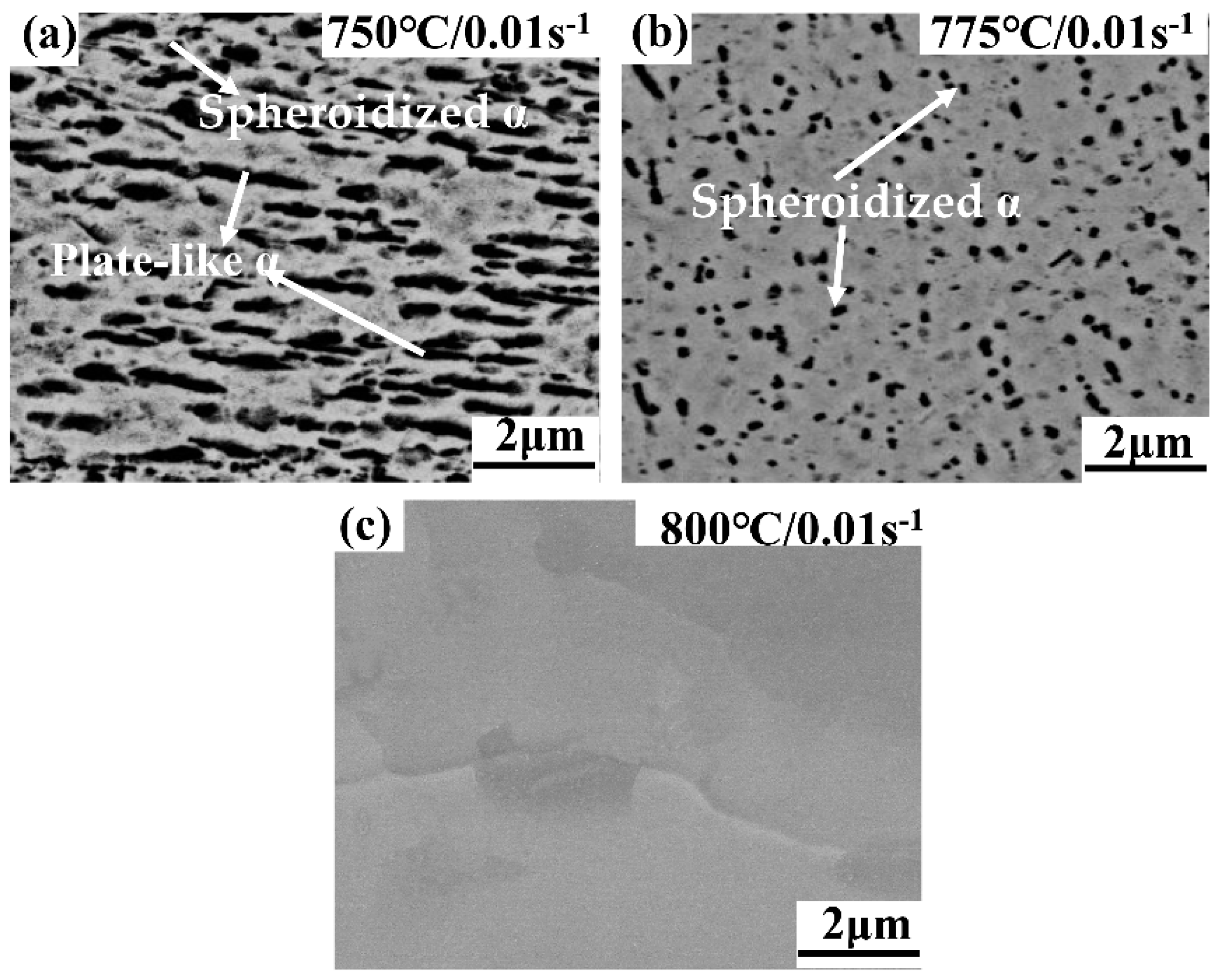

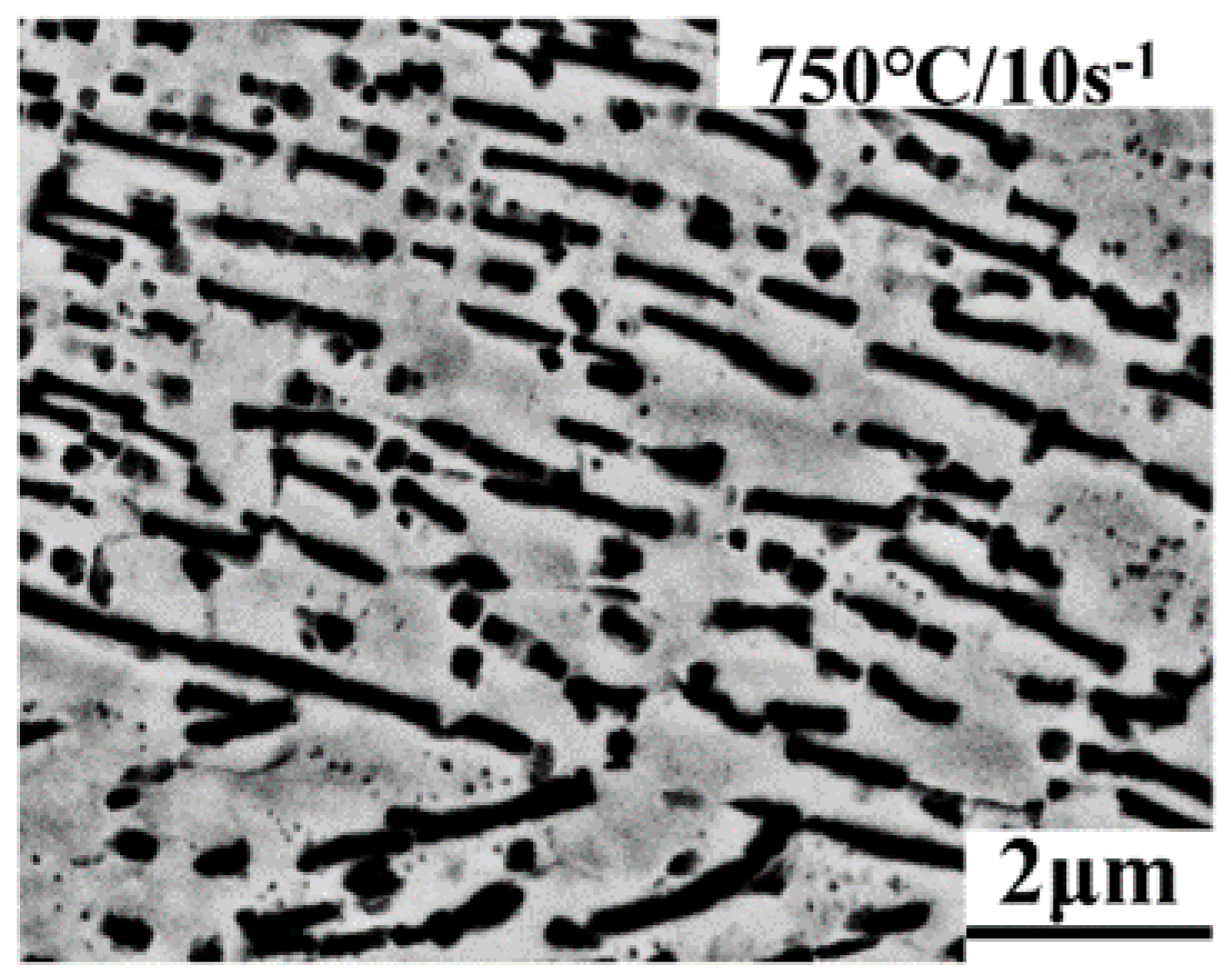


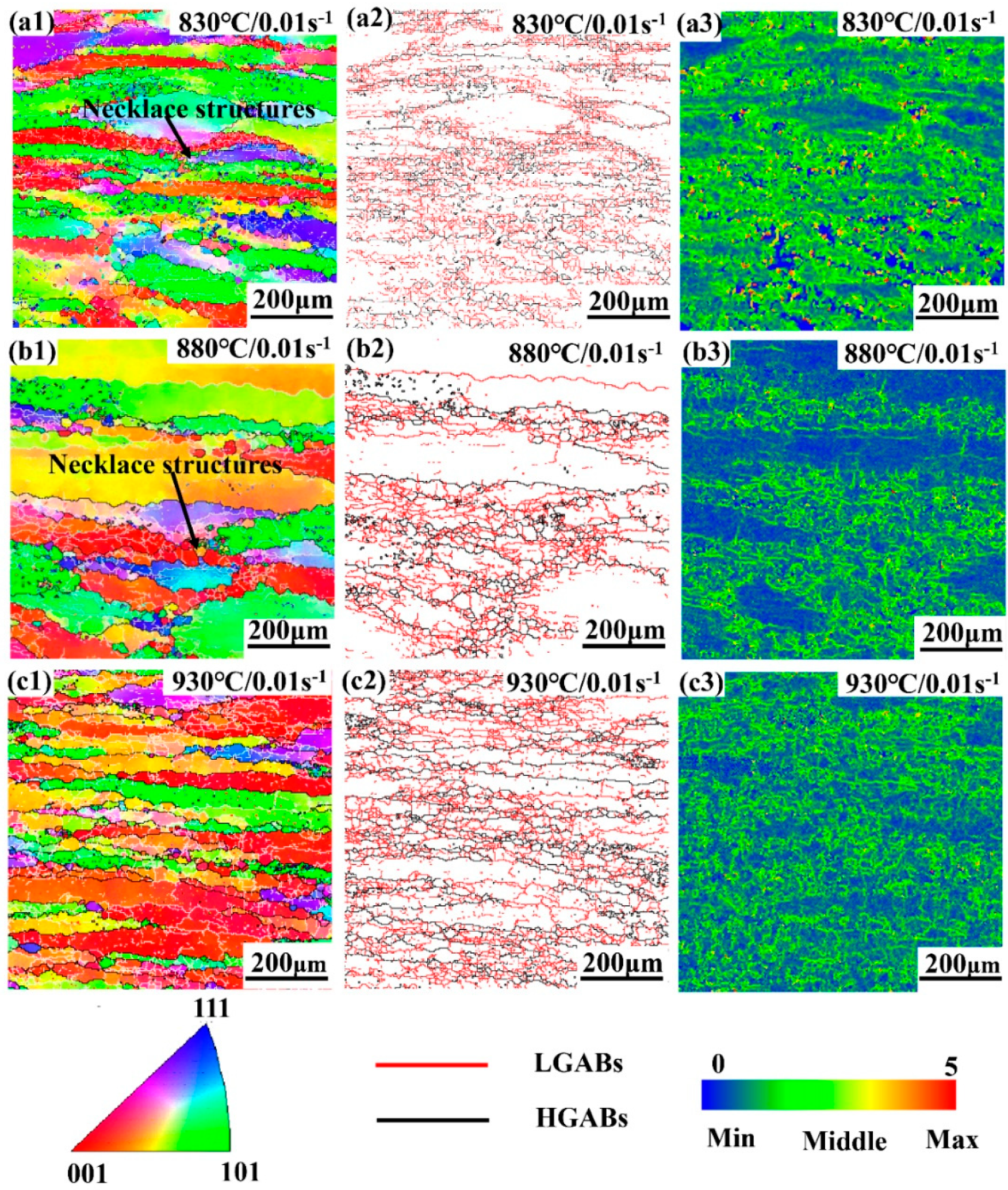


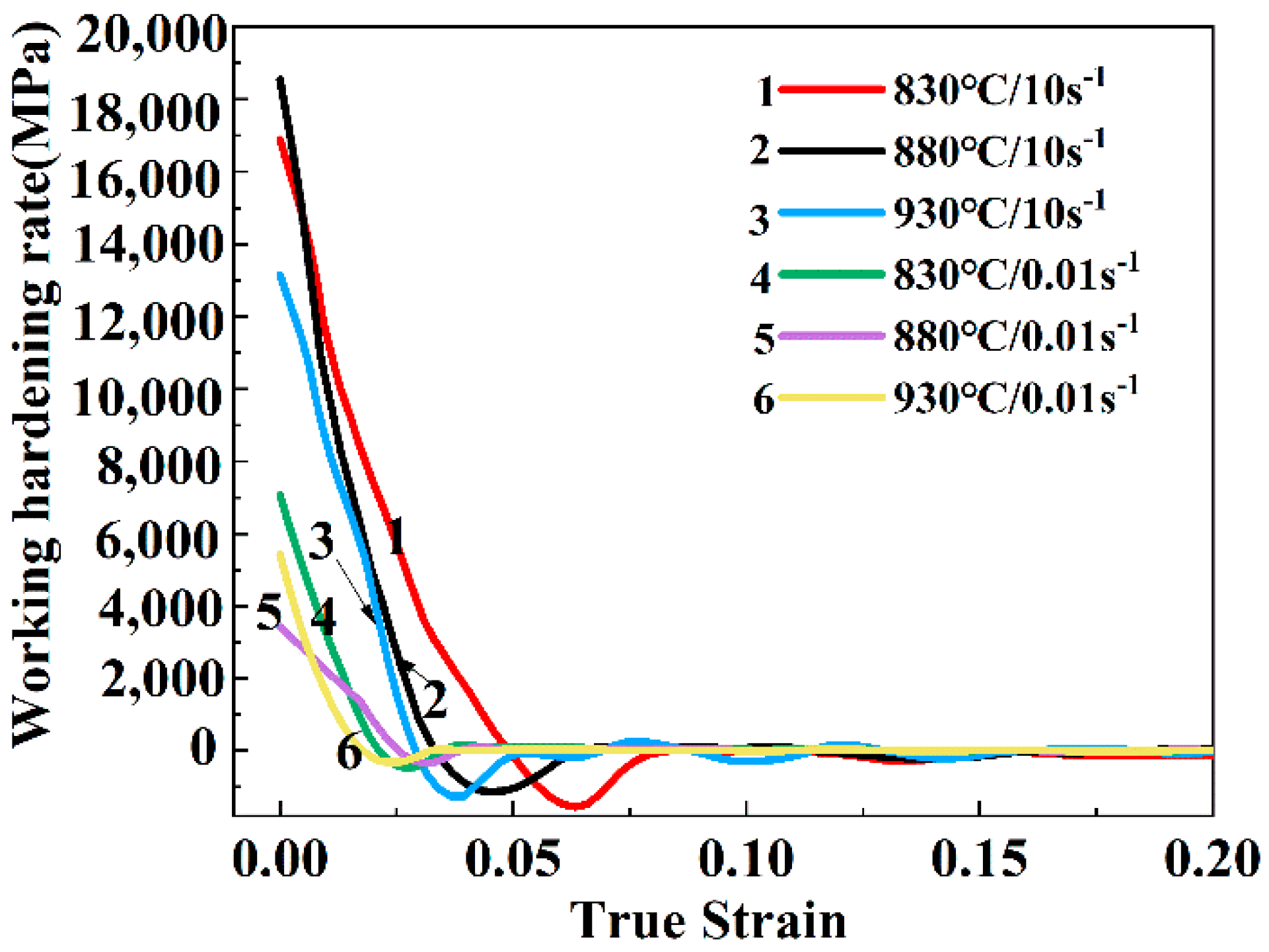
| Element | Al | Mo | Cr | Fe | Zr | C | H | O | N | Ti |
|---|---|---|---|---|---|---|---|---|---|---|
| (wt%) | 2.78 | 4.56 | 3.89 | 0.98 | 1.78 | 0.034 | 0.005 | 0.098 | 0.007 | Balance |
| Temperature /°C | Strain Rate /S−1 | Deformed Fraction /% | Sub-Structured Fraction /% | Recrystallized Fraction /% |
|---|---|---|---|---|
| 830 | 0.01 | 75.92 ± 0.99 | 21.83 ±0.37 | 2.25 ± 0.02 |
| 830 | 10 | 88.83 ± 0.99 | 6.82 ± 0.32 | 4.35 ± 0.01 |
| 880 | 0.01 | 26.74 ± 0.24 | 71.38 ± 0.91 | 1.88 ± 0.01 |
| 880 | 10 | 89.06 ± 0.90 | 8.22 ± 0.097 | 2.72 ± 0.02 |
| 930 | 0.01 | 51.99 ± 0.39 | 45.01 ± 0.32 | 2.99 ± 0.02 |
| 930 | 10 | 13.25 ± 0.11 | 86.17 ± 0.23 | 0.57 ± 0.03 |
© 2020 by the authors. Licensee MDPI, Basel, Switzerland. This article is an open access article distributed under the terms and conditions of the Creative Commons Attribution (CC BY) license (http://creativecommons.org/licenses/by/4.0/).
Share and Cite
Zhou, D.; Gao, H.; Guo, Y.; Wang, Y.; Dong, Y.; Dan, Z.; Chang, H. High-Temperature Deformation Behavior and Microstructural Characterization of Ti-35421 Titanium Alloy. Materials 2020, 13, 3623. https://doi.org/10.3390/ma13163623
Zhou D, Gao H, Guo Y, Wang Y, Dong Y, Dan Z, Chang H. High-Temperature Deformation Behavior and Microstructural Characterization of Ti-35421 Titanium Alloy. Materials. 2020; 13(16):3623. https://doi.org/10.3390/ma13163623
Chicago/Turabian StyleZhou, Danying, Hua Gao, Yanhua Guo, Ying Wang, Yuecheng Dong, Zhenhua Dan, and Hui Chang. 2020. "High-Temperature Deformation Behavior and Microstructural Characterization of Ti-35421 Titanium Alloy" Materials 13, no. 16: 3623. https://doi.org/10.3390/ma13163623





